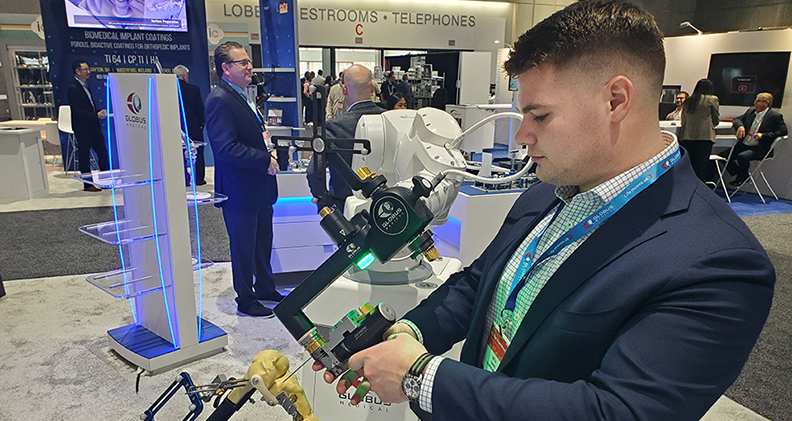
We spent a productive few days at last week’s AAOS Annual Meeting, where we met with industry reps, sat in on education sessions and checked out advancements in orthopedic care throughout the exhibit hall.
The latest developments in surgical robots and navigation systems were on full display, along with innovative ways to fix damaged cartilage and torn tendons in knees and shoulders. Here are a few of the highlights of our time well-spent in San Diego.
Cutting-Edge Joint Replacements
Enabling technology is here to stay, but the real issue orthopedic companies must recognize is the economic pressure facing the industry, according to Tim Czartoski, President of U.S. Surgical and Global Product and Enabling Technologies at Enovis. “The demand for efficiency is undeniable,” he said, “as is the shift toward performing procedures in ambulatory surgery centers. Given this landscape, we must be intentional in our approach to developing technology.”
Czartoski mapped out a clear strategy for Enovis, which he said is committed to delivering technology that simplifies procedures for surgeons and enhances clinical efficiencies. “If we can’t look at platforms through that lens, we won’t pursue developing it,” he said.
Stryker debuted several new advancements to the Mako robotic line, including a first-to-market robotic hip revision capability and Mako 4, a multi-specialty platform with new premium capabilities for total hip, total knee, partial knee and spine.
Keith Evans, Vice President and General Manager of Stryker’s enabling technology business, acknowledged the company’s recent decision to divest its spine implant business to Viscogliosi Brothers while maintaining control of Mako Spine.
“Mako has the necessary capabilities, a strong install base and a sophisticated team that’s developing the platform,” Evans said. “It became an obvious choice for us to go all in on Mako. At the same time, we aligned those efforts with the work being done by the hip, knee and shoulder teams on the same platform.”
Globus Medical showcased the ExcelsiusFlex robot, which received FDA 510(k) clearance last June. The robot represents Globus Medical’s entry into the robotic knee replacement market. It meets the industry standard of sub-millimeter accuracy and gives surgeons the option to employ imageless and CT-based registration.
“Other companies are firmly committed to CT-based workflows,” said Seth Davis, Product Manager of Joint Reconstruction Robots at Globus. “But is that the right approach for every surgery? Not necessarily. For some surgeons and procedures, the imageless workflow makes the most sense. Giving them the option highlights our entry point to the market.”
THINK Surgical featured the upgraded TMINI 1.1 system, which allows surgeons to assess soft tissue balance in the knee and make necessary adjustments intraoperatively. THINK Surgical has partnerships with nine 510(k)-cleared implant partners to integrate their devices for use with the implant-agnostic TMINI.
Mark Ibison, THINK Surgical CFO, shared the findings of the company’s survey of 250 high-volume knee replacement surgeons while speaking at the Canaccord Genuity Musculoskeletal Conference, held the day before AAOS. The results showed that 63% of surgeons who use Zimmer Biomet’s ROSA would prefer to use another robot to place the company’s knee implants. He said the findings are indicative of a dilemma many surgeons face.
“They’re looking for a combination that doesn’t currently exist — the ability to pair their preferred implant with their preferred robot,” Ibison said. “They don’t want to be forced into a compromise. What they truly want is the flexibility to choose their implant and robotic system independently. TMINI makes that possible.”
Smith+Nephew’s CORI robotic solution is one of the only platforms on the market that’s FDA-clearedfor knee revision surgery. Surgeons use the system to model and map the extent of defects across various knee compartments. During the planning phase, they can precisely measure the distance of the defects from the intended implant placement, allowing them to select the appropriate size for revision procedures and reduce the trial and error often associated with manual approaches.
CORI can also be used for partial and total knee replacements, and a hip application is in limited release. Smith+Nephew expects to fully launch the application this year, and a shoulder application is in development.
VISIE’s Continuous Anatomic Auto Tracking (CAAT) technology took home the top prize at OrthoPitch, a live competition inspired by Shark Tank that promotes innovative solutions aimed at advancing orthopedic care.
During a typical knee replacement surgery, surgeons insert tracker arrays around the joint and collect 40 to 100 points per bone to register them to the anatomy. VISIE’s technology almost instantly captures more than 376,000 data points across the joint’s anatomy. It also identifies the precise positions of the femur and tibia throughout the joint’s entire range of motion, allowing surgeons to optimize soft tissue balance in the joint.
Orthokey showcased its ROBIN robot, which recently obtained approval under the CE Mark and is the only open-platform knee robot available on the European market. ROBIN supports precise bone resections, accurate overall limb alignment, soft tissue assessment and gap balancing. Orthokey plans to bring ROBIN to the U.S. market.
Bridging the Treatment Gap
Knee and shoulder preservation and repair were common themes in the exhibit hall, with several companies highlighting solutions aimed at preventing or at least postponing the need for joint replacement surgery.
Overture Orthopaedics is addressing the challenge of treating focal cartilage defects in otherwise healthy knees. “While the defect causes pain, treatment options vary,” said Chad Rains, Vice President of Product Experience and Clinical Services at Overture.
Younger patients may benefit from biologics, cartilage grafts or lab-grown chondrocytes that are re-implanted into the knee — approaches that work well for individuals with strong healing potential.
“But what about patients between 35 and 55, or even 60?” Rains asked. “Their healing capacity isn’t the same as younger individuals, making biologics less effective. At the same time, they may not be ready for a unicompartmental or total knee replacement.”
For these patients, the company’s OvertureTi Knee Resurfacing System fills defects with a metal component, preserving the surrounding cartilage and soft tissues. “We offer different sizes for the femur and tibia to precisely address the defect while maintaining the integrity of the knee,” Rains said.
In February, Atreon Orthopedics received 510(k) clearance for BioCharge Autobiologic Matrix, a bioresorbable implant designed to address biological failure in rotator cuff repair. The fully resorbable, synthetic nanofiber scaffold is designed to optimize the healing environment, promote tissue remodeling and improve long-term outcomes.
Steven Ogg, Vice President of Business Development at Atreon Orthopedics, said the material fully resorbs in three to four months, closely mimicking the native extracellular matrix.
“Effective rotator cuff repair boils down to product consistency,” Ogg said. “The composition and polymers of the BioCharge implant are consistent. In contrast, biological materials vary, impacting the efficacy of dermis-based products.”
Cheryl Blanchard, Anika Therapeutics CEO, said the company recently completed a strategic refresh that included last year’s full market release of the Integrity Implant System. Blanchard said the regenerative implant, which is designed for tendon augmentation and repair, has seen an impressive 40% sequential growth since launching.
Blanchard also highlighted the pending emergence of Hyalofast, a single-stage, off-the-shelf hyaluronic acid matrix used for the repair of chondral and osteochondral lesions.
“With a stable shelf life, it can be stored in a surgical facility, making it immediately available when needed,” she explained. “Given that many cartilage lesions are incidental findings — often discovered during procedures like ACL reconstructions or meniscus repairs — having a solution that surgeons can grab off the shelf and use on the spot could be a game-changer.”
Anika is in the process of filing for FDA approval of the product, which is available in over 30 countries outside the U.S. and is supported by 15 years of clinical data. It has been granted FDA Breakthrough Device Designation.
“Unlike some existing cartilage repair solutions, Hyalofast does not require a second surgery to implant and will be offered at a price point that’s significantly lower than current market alternatives, which can cost $50,000 to $60,000 per procedure,” Blanchard said.
Hyalofast, which could significantly expand access to cartilage repair treatments, is expected to enter the market by next year.
Brinter showed off the potential future of tissue repair with its 3D bioprinting technology, which allows the company to design and print biocomposite implants for various orthopedic applications.
Its initial products are multi-material augmented patches that integrate natural polymers and biological materials like collagen, allowing for the printing of layered structures with enhanced functionality.
The company’s goal is to create implants that function like an extension of the body, providing increased strength and load-bearing support. This is particularly crucial for rotator cuff repair and ACL reconstruction.
Brinter’s initial product launch will feature three standard patch sizes, but the company has plans to offer personalized options.
“One of our upcoming developments is a patient-specific meniscus implant, which will require FDA Premarket Approval,” said Tom Alapaattikoski, Brinter CEO and Co-founder. “When a meniscectomy is performed, we aim to immediately print a custom-fit cartilage replacement to fill the removed section, restoring function more effectively than current methods.”
DC
Dan Cook is a Senior Editor at ORTHOWORLD. He develops content focused on important industry trends, top thought leaders and innovative technologies.




